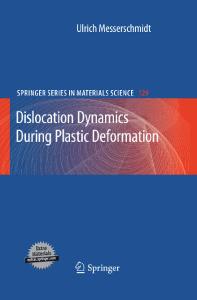Direct Measurement of Dislocation Exhaustion Rates During Plastic Deformation of Ni 3 Al Compounds
- PDF / 746,908 Bytes
- 6 Pages / 408.96 x 639 pts Page_size
- 84 Downloads / 381 Views
The main assumptions for the interpretation of the above transients are summarized in the following (a complete treatment can be found in [5,6]). The first one is the Orowan equation which states that the plastic strain rate jp is proportional to the average dislocation velocity (v) times the mobile dislocation density (Pm). The dislocation velocity is assumed to be thermally activated, Veff being the corresponding microscopic activation volume. The applied stress can be decomposed into a long range athermal stress Ti and an effective stress T*. During the transients, the stress (stress relaxation experiment) or the strain (creep experiment) exhibit a logarithmic behavior as a function of time t. We have observed this type of dependence in a number of experiments on a range of materials and testing conditions with only one exception so far: Ni3(A1,Ta) between 430 and 550 K [7]. An apparent activation volume Va is defined (which is proportional to the reciprocal of the strain-rate sensitivity S) (1)
V=kTAlny A't
in a test at temperature T in which the strain rate and the stress change consequently. A structural parameter Q can be defined [8] such that:
(2)
Va =2vff For the two types of transients of interest here, the expressions of Qiare respectively [8]:
and 92, - 1 = K(1 +-) M
K--(1 +r r - 1= P +M M
(3)
where the subscripts r and c refer to parameters regarding relaxation and creep transients, respectively. M is the elastic modulus of the specimen-machine assembly, K is the strain-hardening coefficient during the transient, defined as:
(4)
and K.=
Kr = •T
where y and Tare respectively the total strain and the applied stress. 03in relation (3) is a mobile dislocation exhaustion parameter defined by [8]:
1.=
ikT
In (pm/Pmp)
(5)
KffA
where Pmo is the mobile dislocation density at the onset of the transient, Pm the same parameter at one stage of the transient where the effective stress is At*. In a logarithmic relaxation test, the stress decrease At (At >0) over a time interval At is [8]: At
kT l=UIn~+Atj V. with c6=
T)
(6))ma'P
where jpo is the plastic strain-rate at the onset of the relaxation. Under such conditions, a fit of (6) with the relaxation curve provides V'. Veff is obtained through a recurrence relation given in [3]. Veff provides a hint for the rate controlling mechanism. Vr and Veff being experimentally determined, Q is computed via relation (2). , contains information about Kr and Pr according to (3). Knowing P from experiment allows to compute pm'Pmo from (5). More precisely, we define a mobile dislocation exhaustion rate Apm/Pmo, by considering the decrease Apm of the density which corresponds to a decline of one order of magnitude of the initial relaxation rate [8]. Inspection of KK5.17.2
(3) shows that K, and j3,cannot be fully determined as Q, is known. Reasonable assumptions can be made about Kr: (7)
0_< K, < 0
where 0 is the work hardening coefficient measured along the stress-strain curve. Therefore two corresponding extreme values of P, can be obtained from (3), whi
Data Loading...











